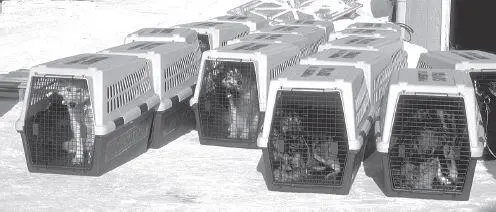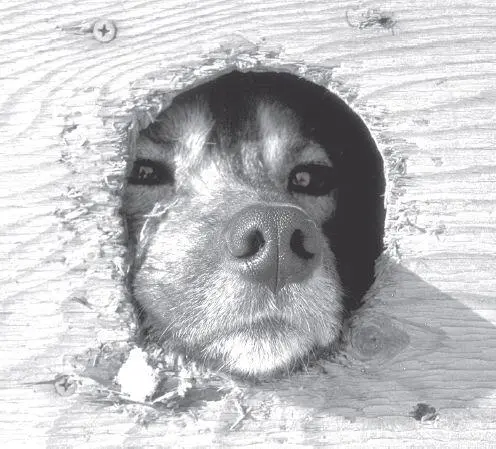From these staging points, everything is entrusted to the “Iditarod Air Force” for movement to the outlying checkpoints. The IAF consists of volunteer pilots using their own planes, some on skis, some on wheels, some on both; the race committee pays for (or arranges donations of) gas, oil, and insurance, and provides food and warm places to throw a sleeping bag at night. This is far cheaper than an equivalent amount of charter airlift (estimated at more than a quarter of a million dollars), which the always strained race budget cannot afford.
Flying for the race can be a lot of fun, but it is even more work — and is sometimes dangerous because of the places and conditions which are an inherent part of the race. In the history of the IAF and its tens of thousands of hours in the air, a few airplanes have been damaged or lost, but no IAF pilots or passengers have ever been seriously injured — which is just short of amazing, considering the abysmal conditions which often prevail. In any case, the informal selection process usually limits the IAF to experienced Alaskan pilots.
Some of the loads in IAF planes run to the truly eclectic: everything from trail marking stakes to snowmachine fuel to tent stoves and the tents they go in. Sometimes this even includes the proverbial kitchen sink (in the form of portable camp kitchens). Packs and sleeping bags stuffed to the ceiling and dogs on passengers’ laps aren’t uncommon (and these aren’t even the really challenging loads!).
Canines make particularly interesting passengers. A Cessna 185 or 206 with the seats removed can hold 18 or even 20 dogs, and race pilots have developed unique tricks and techniques to ensure harmony during flights which could otherwise be, well, eventful.

An army of airline kennels holds dropped dogs waiting at Galena for an airplane ride back to Anchorage. Dogs with serious problems are given special flights directly to veterinary hospitals in Anchorage as quickly as possible.
One ubiquitous commodity in IAF planes is dog food. The dogs dine like kings on the race, wolfing down 5,000 to 10,000 calories each day. Their food includes lots of protein, fat, and other high-energy stuff. Some mushers make their own concoctions from ingredients like fish, moose, caribou, and seal meat. (One musher from the Bering Sea coast likes to stuff seal carcasses in his bags — skin, hair, flippers, and all — because that’s what his dogs normally eat.)
Fortunately, the “dog food” is stored outside and is normally frozen solid. Now and again, however, a harried IAF pilot forgets what he’s hauling and turns up the cabin heat, resulting in a near in-flight emergency as acrid, eye-watering fumes from fish or seal oil waft forward from the thawing bags. (Yes, you can fly with your window open at 20 below zero if you have to.)
At each checkpoint along the trail, there are numerous race personnel with specific functions. The first person the musher sees on pulling into a checkpoint will usually be the checker, often a local resident who is a musher himself. The checker will record the official times and count the dogs, and may formally inventory the sled for the required gear. The checker often has one or more assistants who help him keep track of the official arrival and departure times for each team, and make sure each musher’s pre-positioned food and supplies are readily available.
A musher is automatically disqualified if he or she does not physically have every dog that left the previous checkpoint. If a dog becomes tired, sick, injured, or worse, it must be still be carried to the next checkpoint, which will usually be manned by at least three veterinarians (also volunteers, from the International Sled Dog Veterinary Medicine Association). Every dog on every team is given a quick exam at every checkpoint.
The first concern is for the dogs. If a vet believes a dog is not fit to go on, or if the musher does not want to continue with a dog, it is dropped. The vet can also treat a dog on the spot and let it continue the race, if appropriate. Dogs dropped at outlying checkpoints are cared for by the vets until they can be flown by the IAF back to a hub, from which they are returned to Anchorage on donated air cargo runs.
“Communicators” (amateur radio operators) are at the checkpoints; they run the race communications net using radios, telephones, or even fax machines. Operating at some locations in tents with generators and batteries, the hams pass arrival and departure times, relay logistics information along the trail, and handle personal messages. The communicators have saved lives on the trail by calling in emergency airlift to mushers — and dogs — who have had serious accidents or medical problems.
Logistics staffs are located at the major hubs (Anchorage, McGrath, Unalakleet, Galena, and Nome). These can include half a dozen people, ranging from a logistics coordinator to dog handlers. The race pilots also base out of these hubs, which provide fuel, communications, and a safe place to tie down airplanes in the face of rapidly changing weather.
A staff of race judges, headed by the race marshal, works the entire trail. These are selected mushers who have previously run the Iditarod. They decide questions of race rules and conduct and can impose a broad range of penalties, including disqualification if necessary.
There is also an overall race manager, who is the single person most responsible for the staging of the race; he is selected a year ahead of time and becomes one of the tiny cadre of full-time race employees. During the race, he and the race marshal usually have dedicated IAF airplanes to move them wherever they need to go along the trail.
A highly select team of several volunteer trailbreakers gets one of the more enviable jobs of the entire race: riding high powered snowmachines from Anchorage to Nome at race expense. While some parts of the trail are routinely used for village-to-village snowmachine traffic during winter, many other segments must be groomed for the race or even built from scratch. Mushers could break the trail if required (and must sometimes do so in any case), but the lead mushers would be penalized for it by wearing out their teams. To keep it all fair, and to add to the safety margin, the race organization breaks and marks the trail.

A dropped dog waits for a plane ride home. Tired, sick, injured, or unneeded dogs can be dropped at Iditarod checkpoints. They will be cared for by race vets and handlers until they return to Anchorage.
The trailbreakers use special long-track snowmachines towing big freight sleds to pack the trail and to carry trail-marking supplies (usually four-foot wooden stakes with reflective tape which the mushers can see at night with their headlamps). On occasion, they also must build temporary bridges over open streams and clear brush and trees.
They try to stay no more than six hours or so ahead of the lead teams; any farther ahead and the wind could drift the trail shut behind them. On the other hand, they can’t drop so far back they hinder the mushers, although weather sometimes gets so bad trailbreakers and mushers alike must hole up and wait it out. A team of trail sweeps brings up the rear of the race, picking up trash and dropped equipment and often shepherding the “red lantern” (last-place) musher along the trail.
At the Anchorage end of the race, a volunteer staff hundreds strong does things like staging various pre-race banquets and social events, dealing with the media, sorting mushers’ food for shipment, picking up and caring for dropped dogs returned from the checkpoints, manning public information booths and hotlines, operating concession stands and souvenir shops, purchasing supplies, soliciting donations, coordinating with sponsors, working with city and state agencies, running a taxi service for race personnel, acting as trail guards for sections of trail in populated areas, and dozens of other functions associated with a major sporting event.
Читать дальше














